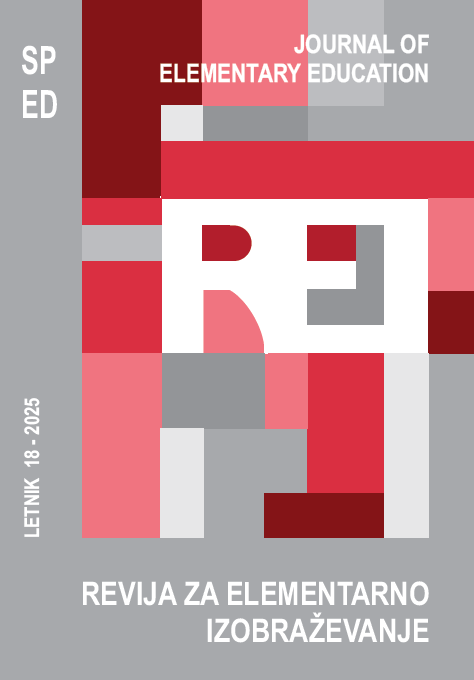University Students' Lifestyle in the Context of Physical Activity, Sedentary Habits, and Academic Achievements
DOI:
https://doi.org/10.18690/rei.5401Keywords:
physical activity, sedentary behaviour, academic achievement, university students, cognitive performance.Abstract
This study aims to explore the relationship between physical activity, sedentary behaviour, and academic achievement among university students. A total of 243 students aged 18 to 24 years participated. Physical activity was assessed using the International Physical Activity Questionnaire – Short Form, while sedentary behaviour was measured with the SIT-Q-7d. Academic achievement was based on self-reported average grades and compared across physical activity levels using one-way ANOVA. Results indicate that higher physical activity is not necessarily linked to better academic performance. Excessive involvement in physical activity may reduce study time, potentially leading to lower academic outcomes.
References
Álvarez-Bueno, C., Pesce, C., Cavero-Redondo, I., Sánchez-López, M., Garrido-Miguel, M., and Martínez-Vizcaíno, V. (2017). Academic achievement and physical activity: A meta-analysis. Pediatrics, 140(6), e20171498.
Badrić, M., Prskalo, I., and Matijević, M. (2015). Primary school pupils' free time activities. Croatian Journal of Education, 17(2), 299–332.
Cohen, J. (1988). The effect size. Statistical power analysis for the behavioral sciences. Abingdon: Routledge, 77–83.
Daley, A. J., and Ryan, J. (2000). Academic performance and participation in physical activity by secondary school adolescents. Perceptual and Motor Skills, 91(2), 531–534.
Daramola, M. A., and Aribasoye, R. M. (2023). Effect of Physical Activity, Exercise and Sedentary Behaviour on Academic Performance of Students in Higher Institutions. European Journal of Theoretical and Applied Sciences, 1(6), 547-556.
Donnelly, J. E., Hillman, C. H., Castelli, D., Etnier, J. L., Lee, S., Tomporowski, P., ... and Szabo-Reed, A. N. (2016). Physical activity, fitness, cognitive function, and academic achievement in children: A systematic review. Medicine & Science in Sports & Exercise, 48(6), 1197–1222.
Erickson, K. I., Hillman, C., Stillman, C. M., Ballard, R. M., Bloodgood, B., Conroy, D. E., ... and Powell, K. E. (2019). Physical activity, cognition, and brain outcomes: A review of the 2018 physical activity guidelines. Medicine & Science in Sports & Exercise, 51(6), 1242–1251.
Hillman, C. H., Pontifex, M. B., Castelli, D. M., Khan, N. A., Raine, L. B., Scudder, M. R., ... and Kamijo, K. (2014). Effects of the FITKids randomized controlled trial on executive control and brain function. Pediatrics, 134(4), e1063–e1071.
Hunter, S., Leatherdale, S. T., and Carson, V. (2018). The 3‐year longitudinal impact of sedentary behavior on the academic achievement of secondary school students. Journal of School Health, 88(9), 660–668.
Kovalenko, A. (2024). Formation of healthy lifestyle of students by means of physical training. Scientific Journal of Polonia University, 62(1), 175–181.
Jančič, J., & Planinšec, . J. (2018). Primerjava športnih dejavnosti učencev iz Maribora in Novega Sada. Journal of Elementary Education, 11(4), 330-340. https://journals.um.si/index.php–/education/article/view/174
Lee, P. H., Macfarlane, D. J., Lam, T. H., and Stewart, S. M. (2011). Validity of the International Physical Activity Questionnaire Short Form (IPAQ-SF): A systematic review. International Journal of Behavioral Nutrition and Physical Activity, 8(1), 115.
Lipošek, S., Planinšec, J., Leskošek, B., and Pajtler, A. (2019). Physical activity of university students and its relation to physical fitness and academic success. Annales Kinesiologiae, 9(2).
Liu, T., and Taresh, S. (2024). The impact of sports participation on college students' learning outcomes: A mixed methods study based on multiple campuses. Journal of Ecohumanism, 3(7), 3649–3666.
Pandolfo, K., Minuzzi, T., Azambuja, C., and Dos Santos, D. (2017). Physical activity and academic performance in high school students. Revista Brasileira de Atividade Física & Saúde, 22(5), 486-492.
Prskalo, I. (2018). Kinesiology and Sustainable Development. Croatian Journal of Education = Hrvatski časopis za odgoj i obrazovanje, 20 (Sp. ed. 3), 321-327.
Sallis, J. F., and Owen, N. (2015). Ecological models of health behavior. In K. Glanz, B. K. Rimer, and K. Viswanath (eds.), Health behavior: Theory, research, and practice (5th ed., pp. 43-64). Jossey-Bass.
Salas-Gomez, D., Fernandez-Gorgojo, M., Pozueta, A., Diaz-Ceballos, I., Lamarain, M., Perez, C., ... and Sanchez-Juan, P. (2020). Physical activity is associated with better executive function in university students. Frontiers in Human Neuroscience, 14, 11.
Sánchez, J. A. O., del Pozo, J., Álvarez-Barbosa, F., and Alfonso-Rosa, R. M. (2024). Longitudinal analysis of the effect of sedentary behavior on body composition, physical fitness, and academic performance in preadolescents and adolescents. E-balonmano.com Journal Sports Science, 20(2), 197–206.
Sánchez-Oliva, D., Leech, R. M., Esteban-Cornejo, I., Cristi-Montero, C., Pérez-Bey, A., Cabanas-Sánchez, V., ... and Castro-Piñero, J. (2023). Sedentary behaviour profiles and longitudinal associations with academic performance in youth: The UP&DOWN study. Journal of Sports Sciences, 41(2), 181–189.
Suárez-Cano, L., Bernal-Ballén, A., and Briceño Martínez, J. J. (2023). A Multivariate Study for Determining the Relationship Between Physical Activity, Physical Fitness, and Academic Performance. Sportis. Scientific Journal of School Sport, Physical Education and Psychomotricity, 9(2), 284-301.
Syväoja, H. J., Tammelin, T. H., Ahonen, T., Kankaanpää, A., and Kantomaa, M. T. (2014). The associations of objectively measured physical activity and sedentary time with cognitive functions in school-aged children. PloS one, 9(7), e103559.
Tremblay, M. S., LeBlanc, A. G., Kho, M. E., Saunders, T. J., Larouche, R., Colley, R. C., ... and Gorber, S. C. (2011). Systematic review of sedentary behaviour and health indicators in school-aged children and youth. International Journal of Behavioral Nutrition and Physical Activity, 8, 1-22.
Vedøy, I. B., Skulberg, K. R., Anderssen, S. A., Tjomsland, H. E., and Thurston, M. (2021). Physical activity and academic achievement among Norwegian adolescents: Findings from a longitudinal study. Preventive Medicine Reports, 21, 101312.
Wijndaele, K., De Bourdeaudhuij, I., Godino, J. G., Lynch, B. M., Griffin, S. J., Westgate, K., and Brage, S. (2014). Reliability and validity of a domain-specific last 7-d sedentary time questionnaire. Medicine and Science in Sports and Exercise, 46(6), 1248-60.
World Health Organization. (2020). WHO guidelines on physical activity and sedentary behaviour. World Health Organization.
Yu, M., Han, X., Wang, X., and Guan, R. (2023). Effects of Physical Exercise on Executive Functions among College Students in China: Exploring the Influence of Exercise Intensity and Duration. Behavioral Sciences, 13(12), 987.
Downloads
Published
Issue
Section
License
Copyright (c) 2025 Ivan Prskalo, Jurij Planinšec

This work is licensed under a Creative Commons Attribution 4.0 International License.
